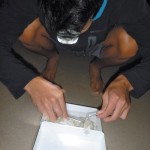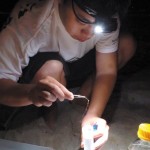Training UH Jellyfish Researchers
Over the past 17 years, University of Hawaii researcher and biochemist Angel Yanagihara literally has spent thousands of hours combing Waikiki’s shoreline in search of box jellyfish.
Yanagihara’s commitment to learn more about the stinging creatures is driven by a near-death experience after being stung by jellies off Waikiki in July of 1997. Her immense respect for these nasty critters is something she wants every staff member who walks through her lab doors to understand and share.
- UH lab staff member Bert Weeks collects box jellyfish on Waikiki Beach for research
- Lab staff member Dane Furutani carefully picks up a jelly
- A box jellyfish specimen. Bert Weeks photos
“Our box jellies are potent stingers capable of sending a volunteer to the hospital,” says Yanagihara.
“Apart from necessary caution to avoid stings, even the apparently simple task of picking up the jellies is critical.”
It’s one of the main reasons Yanagihara takes great care when training student assistants, who include UH undergraduates, graduate students and technicians. She says most assistants stay with her for one to two years, although two members at different points worked with her for six years: “Which was wonderful, in terms of the progress we were able to make,” she says.
“Given this turnover, training is a constant part of running the lab. But just recently I had a nearly full turnover, and now have six new staff.”
Yanagihara says their delicate research depends on maximizing the collection of fully loaded live tentacles packed with stinging cells. Being properly trained is critical to the entire process.
Much of their work during monthly influxes happens in darkness, usually 2-7 a.m. She says putting in long hours requires a degree of commitment, discipline and dedication.
“As the animal beaches, bright-pink tentacles are depleted by the physical washing in the waves, and once on shore, the tentacles break down lying on the sand,” says Yanagihara. “We work in teams to spot the incoming jellies and rapidly pick them up before they start to dry out. We also must work quickly to excise the still-live tentacles and place them in the proper storage solution for further biochemical work. The key to our biochemical success starts at this very first step!”
You could say Yanagihara’s intense training program is like “jelly bootcamp.” Only the serious need apply.
“I do try to push the team hard to master all the skills needed for my lab to maximize our research progress,” she says. “This includes completing all the UH-mandated lab-safety training modules to reading my previous publications and basic background to learning the proper techniques for the night field collection.”
Yanagihara is pleased with her long-standing partnerships with Honolulu City and County Ocean Safety personnel and Honolulu Police Department in order to gain access to the beach. Understanding those relationships is also part of the training process.
Of course, there are liabilities that come with intense research.
All volunteers are required to complete proper paperwork and must attend a lab-based pre-action briefing. Yanagihara says it is crucial that procedures and protocols are well-laid out and followed.
“My lab’s efforts have led to the longest-published continual data collection in the world on box jelly numbers,” she says with great pride. “In the highly competitive world that is academic research, this is a great accomplishment!”
Yanagihara credits Landy Blair and Gail Grabowsky for starting the research in the late 1980s. Her horrific episode in 1997 led her to Blair and his work, and she’s grabbed the reins ever since.
“My sting prompted my idea to write a proposal to Hawaii Community Foundation (HCF) to study these animals,” she says. “While I have not received committed research or salary support for myself and my staff from UH, the longstanding HCF funding sustained this work during the lean years between federal funding. Kudos to HCF for their commitment to local research and local researchers!”
rkmizutani@gmail.com






